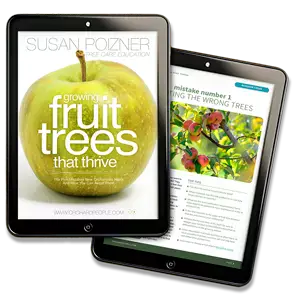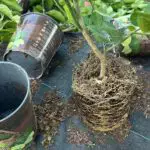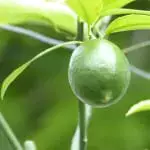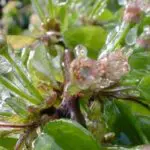How do you choose fruit trees that will work for your landscape? This article and video show you the tips Read more
10 Best Heirloom Apple Trees for Warm Climates: Top Picks for Southern Growers

Years ago, I had the opportunity to visit the Albemarle Ciderworks in Virginia. Their climate is quite different from where I live here in Canada. Our winters are long and cold. But in Virginia, the growing season is longer and warmer and I was captivated by the extraordinary heirloom apple trees thriving there.
It sparked a curiosity in me. I've covered cold hardy apple trees before in my radio show and podcast. I've also explored the heirloom apple trees for cooler climates. But the topic of apple trees for warmer southern climates was new to me. So, I decided to dig in!

In this episode of the Orchard People radio show and podcast, I chatted with Larry Stephenson from Southern Cultured Orchards and Nursery in Coldwater, Mississippi. Larry is a passionate nurseryman who specializes in apple cultivars that thrive in the Deep South regions such as Mississippi, Alabama, and Georgia. These are places where the growing season can stretch up to 10 months and where the air is heavy with humidity.
Now, that kind of heat and humidity might sound great for growing. But for apple trees, it's not so simple.
Chill Hours: Why They Matter in Southern Climates
Here’s the thing: apple trees need a certain number of chill hours—cool temperatures in the winter that help them rest and reset before the next growing season. Specifically, chill hours are the number of hours between 32°F and 45°F during dormancy.
If apple trees don’t get enough chill, they can struggle to leaf out properly, bloom late, or fail to produce fruit at all.
As Larry explains, “You can bring northern apples down this far south, but they have a definite chill limit, which won’t be met.”
So if you’re growing apples in the South, you’ve got to choose low chill varieties—apple trees that don’t need as many cool hours to do their thing.
That’s where Larry’s work comes in.
Fruit Trees
That Thrive

He’s passionate about promoting southern heirloom apple tree varieties that have stood the test of time, heat, humidity, and shifting climates. He believes that many of these apples are also naturally disease resistant, since they thrived long before modern fungicides and pesticides became common. And the best part? Some of these varieties might even do well in northern climates too.

Best Low Chill Apple Trees for Southern US
Here are Larry’s top picks for apple trees that grow beautifully in southern conditions:
Larry's Top Apple Varieties for Warm Climates

1. Cauley Apple: The Southern Favorite
Originating from Grenada, Mississippi, Cauley apples are a staple in southern orchards. These large, green apples are known for their sweetness and productivity, delivering bountiful harvests even in the heat of August. Larry notes their potential for turning red in cooler northern climates, where they could also thrive.

2. Captain Davis: A Civil War Legacy
The Captain Davis apple's tale begins with a Civil War soldier who planted seeds he carried home to Kosciuszko, Mississippi. The tree grew into a robust yet modest apple known for its historical value. Although primarily sweet, Larry suggests it's not the top choice for taste, yet its intriguing backstory makes it a beloved cultivar.

3. Chickasaw Apple: Sweet and Productive
From Chickasaw County, Mississippi, this variety is renowned for its limb-breaking productivity and sweetness. The large, striped red and green apples are a hit for their fresh flavor, marking them as excellent candidates for commercial growth if desired.

4. Yellow Hamilton: The Roadside Gem
A discovery from Hamilton, Alabama, this large, golden apple shines with a sweet profile that rivals the popular Golden Delicious but suits the southern climate better. Noted for its potential as a commercial cultivar, Yellow Hamilton represents another step towards regional orchard success.

5. Shell of Alabama: Complex and Delicious
Shell apples, originally from Mobile, Alabama, exhibit a complex flavor profile. This medium-sized apple surprises with a combination of sweet, tart, and astringent notes. Once a staple of train shipments to the Northeast, the Shell apple stands out for its surprisingly diverse palate.
Why are they called "Shell" apples? According to Lee Calhoun's book, Old Southern Apples, 2nd Edition, Chelsea Green Publishing (affiliate link), they are named after Mr. Greenberry H. Shell who was the first to grow this tasty variety.

6. Cotton Gin Apple: A Drought Survivor
Discovered in Northwest Alabama, Cotton Gin apples boast resilience against drought conditions, holding their ground while other varieties falter. With a sweet taste and good storage capabilities, they present a compelling choice for climate-challenged regions.

7. Dixie Red Delight: A Striking Appearance
Hailing from Northern Alabama, this apple’s vibrant mix of russet, red, and olive green colors tell as much of a story as its sweet flavor. Known for their large size, Dixie Red Delight apples offer yet another sweet, attractive choice for southern growers.

8. Pontotoc: A Sweet Surprise
Pontotoc County, Mississippi introduces us to a deeply purple apple that matches an Asian plum's aesthetic. Its rich, sweet flavor has captivated taste buds and piques interest in further testing in northern climates.

9. Yates: The Cider Candidate
A small but powerful crabapple from Northern Georgia, the Yates apple is packed with sweetness and astringency, offering potential as a cider apple. Despite its size, its flavor makes a lasting impression.

10. Sebren: Ideal for Southern Palates
Sebren apples hail from Southern Mississippi and straddle the line between cooking and fresh-eating varieties. Their balance of sweet and sour makes them versatile in the kitchen and valuable in the orchard.
Larry reminds us that every apple variety has its own fans, and your favorites might change from one season to the next. In fact, the weather that year and growing location can change the flavor of the apples produced from year to year. But when you grow trees that are adapted to your climate—and suited to your chill hour range—you’ll set yourself up for success.
For more apple-growing tips and interviews like this one, check out OrchardPeople.com or hop over to our YouTube channel. Whether you’re just starting or you’ve got an orchard in the backyard, finding the right tree for your region is the first step to a sweet harvest.

Susan Poizner
Learn more about Susan on the about us page.



